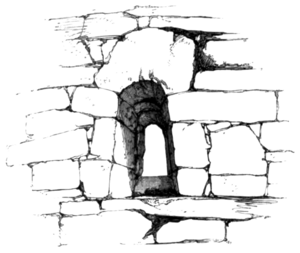it is one of the Irish fashions which may be traced from the earliest to the latest times, and, like the doorways before mentioned, is in itself no evidence of date; it occurs in many of the small churches, which, from their extreme plainness, may be of any period, as well as in houses and castles. A window with sloping sides and a round head, cut out of a single stone, is also of frequent occurrence, as at Ross, co. Galway. The very great thickness of the walls, in many instances, may also be attributed to the nature and the abundance of the material; and this rendered buttresses altogether unnecessary.
The peculiar tongue-shaped corbel, which is another Irish fashion throughout the Middle Ages, may perhaps also have been originally due to the material; it required less cutting, and the stone could be more easily trimmed into that form of corbel than any other.
Another point which must be considered in treating of houses in Ireland is the character of the people from the earliest period of history: they were pre-eminently a belligerent people, always fighting among themselves if not with their invaders. Accordingly, we find from primitive times that the idea of defence seems to have been always uppermost in the mind of an Irishman when building his house; the first thing to be considered was, how best to keep out an enemy. In the subterranean abodes and the bee-hive houses the entrance is so small and low that a man can only get in by crawling on his hands and

